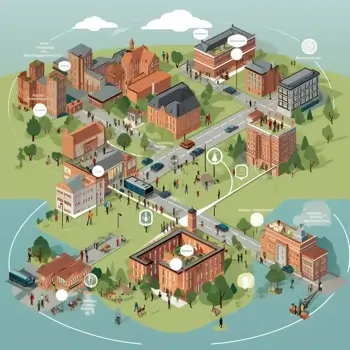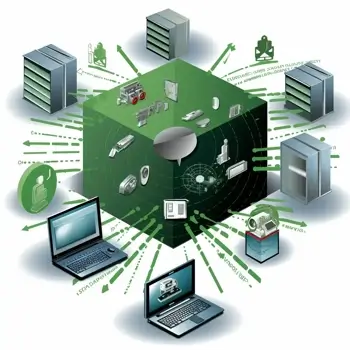What Is a Computer Network?
In general, computer networking and digital technology can be a challenge for many people. But when you break computer networking down to its foundation, it's not so difficult to understand. Learn about computer networking in this article, including what it is, why it's important, and different types of networks.
What is a computer network?
A computer network is a group of devices that share resources and exchange data. They also communicate to offer services and offer services. A network consists of hardware such as servers, clients, routers, switches, and modems. It also includes software like a Network Operating System (NOS) and communication protocols.
It connects multiple devices, allowing them to communicate with each other. Networked devices can include personal computers, phones, printers, servers, and refrigerators; essentially, it includes any network connection device.
With computer networks, communication allows for the sharing of resources among devices. Before networking existed, we could only perform one-to-one communication between devices. This meant that in the office, every single computer needed its own printer in order to print documents. Computer network infrastructure, however, allows all the network computers to connect and print from one central printer.
Now, almost everything we do relies on computer networking. Whether you're shopping online, streaming Netflix, or sending emails, computer networking is a necessary part of the process.
Types of computer networks

Computer networks vary depending on the size, design, organization, and transmission medium. As networks get bigger, their architecture becomes more complicated. In some cases, dividing the network into smaller parts helps to manage its size more effectively. This article covers just the basics of computer networking.
From smallest to largest, here are the different types of networks.
Personal area networks (PANs)
One person uses this network in a small space, such as a personal office. These networks connect personal devices like laptops, speakers, tablets, and phones using wireless technology like Bluetooth or WiFi. Personal area networks are like LANs, just more individualized.
Local area networks (LANs)
A local area network connects devices in a small geographic area like a home, school, or office building. LANs usually connect these devices via switches or a router using the TCP/IP communication protocol. LAN connections can be either wired or wireless, although wired connections are usually much faster.
LANs are usually faster than other types of computer networks. They are small and have a limited number of devices. Within a LAN, routers serve as the gateway for devices to connect to external networks.
Campus area networks (CANs) and metropolitan area networks (MANs)
Both CANs and MANs are large networks made up of many linked LANs. Universities, organizations, and governments use CANs to connect different buildings or regional offices to each other. Metropolitan area networks cover larger geographic areas like cities or localities. They may also serve as Internet service providers (ISPs) for geographic regions.
Wide area networks (WANs)
Wide area networks cover large locational areas such as cities, regions, and even countries. They are the largest type of network; like CANs and MANs, they connect smaller LANs into one network. We consider the Internet itself to be a WAN.
Wireless local area networks (WLANs)
A wireless local area network is a type of wireless network that allows multiple devices to be wirelessly connected. It forms a local area network in a smaller space. Rather than using wired connections, WLANs instead utilize high-frequency radio waves to establish a coverage area. WiFi, used in most homes and offices now, serves as an example of a WLAN.
Components of a computer network
Computer networks range in size. The largest is the Internet, while the smallest and most basic is the personal area network (PAN). Big or small, networks connect devices, links, communication protocols, and defense systems. To understand how computer networks function, consider a home wireless local area network (LAN) as an example.
Home networks consist of various devices, including computers, phones, gaming devices, and printers. However, routers and switches are also necessary for a network to function. There are two types of components in a computer network: hardware and software.
Hardware components
Both routers and switches connect devices to one another across a network. Routers store and send data in packets, while switches direct data from input ports to a specific output port. Routers connect networks to each other and connect those networks to a modem, providing Internet access. Switches connect the devices within a network.
Many home networks use routers with built-in switches to send data and talk to devices on the network. They also serve as gateways that open communication channels with devices on different networks. These networks use links as the transmission medium through which data flows. Most links now are wireless, as most home networks are wireless.
Software components
While hardware components of a computer network are essential, the software components are equally needed. There are two primary software components to any computer network: a network operating system (NOS) and communication protocols.
A network operating system (NOS) is specialized software. By design, it manages and supports the connections between devices on a network. The system allows the devices to properly communicate and share resources. Without the NOS, devices couldn't connect to the network or manage data.
Communication protocols are also essential. These are sets of rules or standards that define how data transmits and arrives between devices on a network. They ensure that devices can communicate effectively and cover all aspects of the communication process.
This includes everything from data formatting and sequencing to error handling. The Internet Protocol (IP), Simple Mail Transfer Protocol (SMTP), and Transmission Control Protocol (TCP) are communication protocols. These protocols allow for communication on a network.
How do computer networks work?
Computer networks allow for computing devices to perform various tasks. This includes exchanging data, communicating messages, and sharing resources with each other across a space. These networks link computers and other computing devices using networking devices, transmission media, and connection protocols.
Networks rely on routers, switches, and other hardware components to direct and manage data flow. Devices on a network send data packets. Routers and other network devices transfer that data to the correct destination efficiently.
Along with this process, networks rely on communication protocols. Transmission Control Protocol (TCP), for example, guides and controls data packets sent across a network. These protocols establish rules for data transmission and ensure safe and reliable communication. Through these two essential aspects, computer networks can share data and properly link devices across a space.
Benefits of computer networks
Using a computer network, whether small or large, has many advantages. It can be a local network or a national one. They improve communication and data usability for users on both ends. Below, find some of the advantages of computer networks.
- Resource sharing. Computer networks allow multiple devices to share resources, which simplifies contact and helps with maintenance and costs.
- Data usability. A computer network makes it easy for users to share and access data from anywhere.
- Capacity to grow. Computer networks can easily scale up or down to accommodate more devices or users.
- Data management. Using networked servers, users can store data centrally, allowing others to access it while protecting the data.
- Enhanced security online. While networks present certain weaknesses, they also allow users to implement more security measures, like firewalls or encryption tools.
How are IP addresses used on computer networks?

Devices need to know each other's location to communicate, even with all the right equipment and technology. This location is called an "address." Network address translation lets many devices use one public IP address, shown on What Is My IP.
Users can also change their IP address using VPNs, proxies, and other methods. Modern networks typically use the TCP/IP model to communicate where each device is, given its IP address.
Some, however, use the OSI (Open Systems Interconnect) model. These systems allow network computers or devices to transfer data and work in conjunction with one another. They use protocols like FTP (File Transfer Protocol) to function properly.
How to defend a computer network
Finally, any strong computer network needs a defense system. Without defense systems in place, networks are vulnerable to attacks from malicious actors. Common network defense systems include:
- Firewalls, which block or allow data packets based on preset security rules set by an administrator
- Proxy servers, secure software systems that act as a gateway between a device and the rest of the Internet
- Single sign-on (SSO), a service that lets users use one sign-on for several different applications
- Virtual private networks (VPNs), which use advanced encryption protocols and secure tunneling techniques to encapsulate all online data transfers
You or your system administrators can employ any protection method you choose. Just keep in mind that networked computers can potentially spread malware or viruses to one another. Protecting the network protects everyone and every device on it.
Computer network topologies
Computer networks have a variety of network topologies. A network topology is the structural arrangement of the network. Each dictates how the components are connected to one another.
This means that the network topology you use is crucial to achieving peak function on your network. The most common network topologies are:
- Point-to-point topology
- Star topology
- Ring topology
- Tree topology
- Full mesh topology
- Hybrid topology
Point to point network topology
In a point-to-point network, there are two nodes: the sender and the receiver. This network is the simplest for communication. It only has two nodes. Data transfers through a dedicated connection.
Star network topology
A star network connects multiple devices, or nodes, to a single central node. This hub connects to the central node with RJ45 connectors or coaxial cables and can be either active or passive. This topology relies on the performance of the central hub for the performance of the entire network.
Ring network topology
A ring network connects devices with two neighboring devices in a network, essentially creating a circular ring shape. This network setup needs lots of repeaters and more than one node for all devices to work correctly. This topology, too, uses RJ45 cables or coaxial cables to connect.
Tree network topology
The tree topology is like a star network but with multiple star networks connected together. Like a tree with a trunk and branches, this topology creates a top-to-bottom data flow from a central hub to secondary hubs. Those secondary hubs or nodes then transmit data to more systems. Computer network admins can easily add more devices to an existing network with this topology.
Full mesh network topology
In a full mesh network topology structure, each devices connects to another via a channel on the network. It allows for fast communication between devices, as there are dedicated channels or links between each device.
Hybrid network topology
A hybrid network is a sort of free-for-all; it combines all types of network topologies. The nodes can take any form on the network. Therefore, it makes this topology extremely flexible and open to adding new devices.
However, these networks require a higher cost and greater planning than other, more basic topologies. This is due to the amount of cabling and network architecture involved,
Frequently asked questions
What are computer networks?
Computer networks are systems that connect computers and other devices. It allows them to share resources and transmit data.
What are the four types of computer networks?
There are four main types of computer networks. These include personal area networks (PANs), local area networks (LANs), metropolitan area networks (MANs), and wide area networks (WANs).
What is an example of a computer network?
A local area network in your office building or place of work is an example of a computer network. Though each person has their own device, they are connected through a central router or modem.